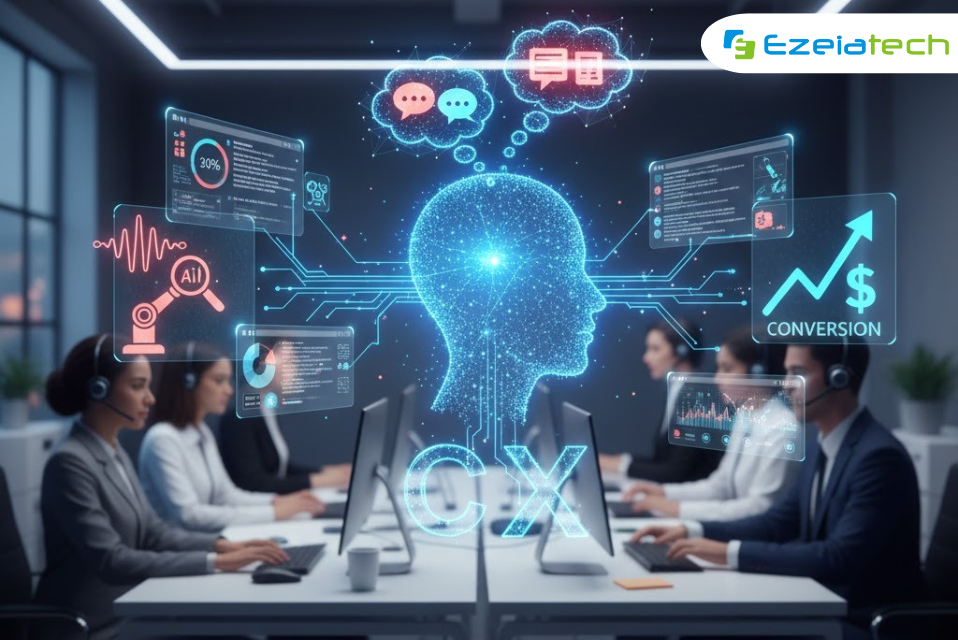Introduction
The online customer experience (CX) is a high-stakes game. Each conversation—whether it’s a brief chat, a support case, or a social media comment—is a moment of truth with the power to build loyalty or push a customer into a competitor’s arms. To succeed here, the basic, rule-based chatbots of the past are becoming obsolete at lightning speed.
The future of high-converting customer service is Conversational AI, driven by intelligent Natural Language Processing (NLP). This is the technology that shifts the conversation from “What are your choices?” to “I know precisely what you need, and here is the solution that will best serve your objectives.”
This shift isn’t just about efficiency; it’s about making every conversation with your brand highly relevant, deeply personal, and, ultimately, a direct driver of revenue.
The Critical Difference: Understanding Intent and Sentiment
The fundamental difference between a basic chatbot and an NLP-powered Conversational AI lies in its ability to understand context and emotion.
- Rule-Based Systems: They depend on keywords. If a customer utters, “I want to cancel my order,” the bot will perform on the word ‘cancel,’ even though the customer meant, “Can you please not cancel my order?”
- NLP-Powered AI: Uses sophisticated models to carry out Sentiment Analysis and Intent Classification. It is able to recognize frustration, urgency, and the real purpose behind the words, making sure the reply is not just correct but also empathetic and appropriate.
This deeper knowledge is not negotiable for today’s customers. Indeed, it has been found that 71% of customers expect customized interactions from businesses, and 76% become upset when this expectation is violated. NLP is the technology that enables personalization at scale.
NLP as the Conversion Catalyst
The actual worth of NLP and AI in CX is its immediate effect on the sales funnel and conversion rate. Chats, when optimized well, become cost centers no more but conversion centers.
1. Speeded-Up Shopping Choices
AI-driven chat tools drive through customer hesitation by offering immediate, highly relevant information and recommendations. By breaking down the customer’s actual queries and browsing history (through NLP), the AI can reduce hesitation and friction.
- The Stat: Shoppers finish transactions 47% quicker when aided by AI, as it streamlines the product discovery process and eliminates checkout friction.
- The Conversion: Speedier decision-making directly contributes to reduced cart abandonment and increased final conversion.
2. Smart Lead Qualification and Routing
On complex sales, AI is an advanced frontline qualifier. It reads the text or speech from initial contact, identifying critical entities and determining lead intent in real-time.
- Process: NLP evaluates lead complexity and interest indicators and gives a “lead score” and then automatically sending high-potential leads to the most appropriate human agent in real-time. This maximizes valuable human sales time spent on the most likely opportunities.
- The Effect: AI-using sales teams experience a boost in productivity, and firms employing AI-powered chatbots have observed a 23% lift in overall conversion rates versus ones without.
3. Frictionless Omnichannel Personalization
Today’s consumers ping-pong between channels—initiating a question on the website chat and then following through via phone or email. If they must restate their problem, the customer experience falls apart.
- The Role of AI: NLP and AI systems combine data from every touch point (omnichannel). When a customer switches, the AI immediately gives the human agent (or the bot) the entire conversation history, past product looks, and present sentiment.
- The Outcome: Companies that implement omnichannel strategies are able to attain a 91% greater year-over-year gain in customer retention rates. Consistency and context fuel loyalty, and loyalty is the key to repeat conversions.
More Than Transactions: Enhancing Human Capability
Conversational AI isn’t about replacing human agents; it’s about enhancing their ability to work on high-value, complicated cases.
- Real-Time Agent Support: NLP-driven tools, typically referred to as “agent assist,” listen in on live calls or read live chats and give agents suggested responses, applicable knowledge base articles, and even sentiment alerts (e.g., “Customer is frustrated!”) in real time.
- The Benefit: This largely minimizes the Average Handle Time (AHT) for difficult cases and results in a better quality, more uniform customer experience. Support agents leveraging AI software were found to process 13.8% more customer requests per hour.
Conclusion
The age of simple chatbots is behind us. The CX advantage in today’s world is with organizations that manage to strategically integrate Natural Language Processing and Artificial Intelligence into all aspects of the customer journey.
Through profoundly engaging with what customers have to say and feel, through actively anticipating their needs, and through steering them smoothly through the funnel, companies can turn everyday customer conversations into transformative, sales-driving Conversations That Convert. The only question now is not whether you should invest in Conversational AI, but how fast you can roll it out at its full NLP-driven capability.







